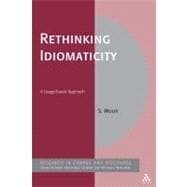
What is included with this book?
| Acknowledgements | p. x |
| Introduction | p. 1 |
| Theoretical issues | p. 8 |
| Introduction | p. 8 |
| Previous approaches to idioms and idomaticity | p. 8 |
| Discourses analysis and the relevance of phraseological units | p. 10 |
| The collocation-idiom continuum in phraseology | p. 11 |
| Idiomaticity as a multifactorial concept: Psycholinguistic approaches | p. 12 |
| A constructionist approach to idioms and idiomaticity | p. 14 |
| Theoretical underpinnings | p. 14 |
| The role of non-compositionality and frequency | p. 15 |
| A usage-based model | p. 17 |
| Placing idioms in the construction | p. 17 |
| Conclusion | p. 19 |
| Methodological issues | p. 20 |
| Introduction | p. 20 |
| (Quantitative) corpus linguistics | p. 20 |
| Data | p. 23 |
| Preliminary considerations | p. 23 |
| The data sample | p. 25 |
| Experimental data | p. 28 |
| Conclusion | p. 33 |
| Compositionality | p. 35 |
| Introduction | p. 35 |
| Previous approaches | p. 35 |
| Non-compositionality approaches | p. 35 |
| Compositionality approaches | p. 36 |
| Idiomatic pattern typologies | p. 39 |
| Corpus-linguistic / computational approaches | p. 41 |
| Towards a new approach to compositionality | p. 44 |
| A pre-test data sample of VPCs | p. 46 |
| Finding an adequate association measure | p. 47 |
| (Dichotomous) p-values do not reflect (interval-scaled) association strength | p. 50 |
| Verb or particle, is that the question? | p. 52 |
| Interim summary | p. 54 |
| A new approach to compositionality | p. 55 |
| Application | p. 55 |
| Results | p. 59 |
| Conclusion | p. 65 |
| Flexibility measures | p. 67 |
| Introduction | p. 67 |
| Previous approaches | p. 68 |
| Theoretical approaches | p. 68 |
| Psycholinguistic approaches | p. 69 |
| Corpus-linguistic approaches | p. 71 |
| Kinds of flexibility | p. 75 |
| A new approach to flexibility | p. 77 |
| The baseline | p. 77 |
| Measure I: An extension of Barkema (1994a) | p. 78 |
| Measure II: Entropy | p. 82 |
| Measure II, version B: Directional entropy | p. 85 |
| Tree-syntactic flexibility (SF) | p. 87 |
| Application | p. 87 |
| Results | p. 88 |
| Lexico-syntactic flexibility (LF) | p. 91 |
| Application | p. 91 |
| General lexico-syntactic flexibility | p. 94 |
| Flexibility of the NP-slot | p. 98 |
| Flexibility of the verb-slot | p. 107 |
| Morphological flexibility (MF) | p. 116 |
| Application | p. 116 |
| Flexibility of the NP-slot | p. 116 |
| Flexibility of the verb-slot | p. 123 |
| Evaluation | p. 141 |
| Conclusion | p. 145 |
| The idiomatic variation continuum | p. 150 |
| Introduction | p. 150 |
| Method: Principal Component Analysis | p. 150 |
| How idiomatic variation parameters cluster | p. 152 |
| Conclusion | p. 154 |
| The idiomaticity continuum | p. 157 |
| Introduction | p. 157 |
| Method: Multiple regression analysis | p. 157 |
| Assessing the relevance of idiomatic variation parameters for idiomaticity judgements | p. 158 |
| Conclusion | p. 160 |
| Towards a new model of idiomaticity | p. 163 |
| Appendices | p. 170 |
| Example of a questionnaire for the elicitation of perceived idiomaticty data | p. 171 |
| Results for compositionality | p. 173 |
| Barkema-based flexibility values for tree-syntactic, lexico-syntactic and morphological flexibility | p. 176 |
| Entropy-based flexibility values for tree-syntactic, lexico-syntactic and morphological flexibility | p. 186 |
| Barkema-based flexibility values for the parameter levels of tree-syntactic, lexico-syntactic and morphological flexibility | p. 196 |
| An overview of the formal flexibility parameters and their parameter levels with corresponding examples | p. 214 |
| Scatterplots displaying the correlation between the two flexibility measures (Barkema-based = 'B', entropy = 'H') | p. 217 |
| References | p. 227 |
| Author Index | p. 236 |
| Subject Index | p. 238 |
| Table of Contents provided by Ingram. All Rights Reserved. |
The New copy of this book will include any supplemental materials advertised. Please check the title of the book to determine if it should include any access cards, study guides, lab manuals, CDs, etc.
The Used, Rental and eBook copies of this book are not guaranteed to include any supplemental materials. Typically, only the book itself is included. This is true even if the title states it includes any access cards, study guides, lab manuals, CDs, etc.